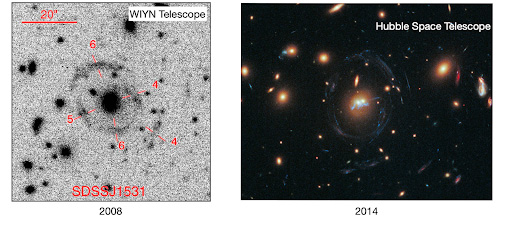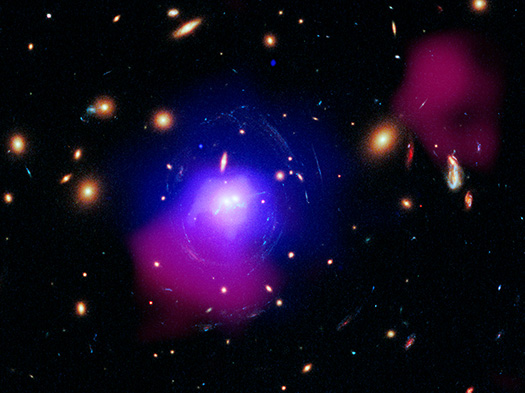Chandra Ties Powerful Black Hole to Stellar Beads-on-a-String

Osase Omoruyi with her parents’ favorite beads.
We are happy to welcome Osase Omoruyi as a guest blogger. Osase is the first author of the paper that is the focus of our latest press release, and is an NSF Graduate Research Fellow at Harvard University, where she is currently completing her PhD in Astronomy and Master’s in History of Science. Osase uses a variety of telescopes, from X-ray through Radio, as well as computer simulations, to study the fascinating life of galaxies. She is particularly interested in how stars and black holes, which are small in comparison to the scale of a whole galaxy, can transform how galaxies change over time.
In 2008, astronomers using the Wisconsin–Indiana–Yale NOAO (WIYN) telescope in Arizona published images of the newly discovered galaxy cluster named SDSS J1531+3414 (SDSS J1531 for short). At first glance, it seemed like a standard massive cluster of galaxies with one giant galaxy in its center, hundreds of others surrounding it, and arc-like structures caused by gravitational lensing – a phenomenon where the cluster's gravity bends light from galaxies behind it.
However, our understanding of SDSS J1531 changed dramatically in 2014 when the Hubble Space Telescope provided a higher-resolution view of the cluster from space. Contrary to initial beliefs, the heart of the cluster housed not one but two massive galaxies, on course to collide and merge into a single entity. They also featured 19 clusters of young stars wrapped around them in a pattern that resembled beads on a string.

The Wisconsin-Indiana-Yale NOAO (WIYN) telescope view of SDSS J1531 vs the Hubble Space Telescope’s view. The Hubble image has been rotated by 53 degrees in a clockwise direction.
Curious about how the 'beads' came to be, we gathered observations of the cluster across various wavelengths of light, from X-rays to radio waves, over the subsequent decade. We discovered that SDSS J1531, like half of galaxy clusters, is enveloped in a shroud of incredibly hot gas that is rapidly cooling and flowing toward the heart of the cluster— where the new stars are located. We also learned that SDSS J1531 is likely in the final stages of a merger between two massive galaxy clusters.
Amidst this dramatic merger and rapidly cooling gas, we discovered evidence for a very old, powerful jet emanating from a supermassive black hole in one of the central galaxies. The magnitude of this jet's outburst is among the highest ever recorded, releasing energy that vastly exceeds the Sun's total energetic output over its entire lifetime by more than 100,000 trillion times. As the jet propagated through space, it carved out a giant bubble in the cooling gas, uplifting and dispersing the surrounding material.
Despite occurring almost 200 million years ago, the legacy of the outburst endures. The previously uplifted gas has now cooled and is gravitating back towards the center of the cluster, and provided the fresh fuel for the young 'beads on a string' star formation.

Galaxy Cluster SDSS J1531+3414 (Credit: X-ray: NASA/CXC/SAO/O. Omoruyi et al.; Optical: NASA/ESA/STScI/G. Tremblay et al.; Radio: ASTRON/LOFAR; Image Processing: NASA/CXC/SAO/N. Wolk)
The discovery of such an immense black hole outburst was very surprising. The Chandra X-ray data alone couldn’t reveal the complete extent of the bubble created by the black hole, and the Very Large Array, from which we hoped to find signals of recent activity from the black hole, found nothing. These observations led us to hypothesize that we might be observing a unique cluster where the black hole had yet to interact with the cooling gas.
However, a pivotal suggestion from our paper’s referee prompted us to comb through LOFAR’s archives at the last minute, where we found radio data that unveiled the remains of the ancient black hole jet. This evidence clarified that the "wings" we had seen in the X-ray images were actually the opening to a giant bubble sculpted by the black hole nearly 200 million years ago, a discovery akin to finding a Cretaceous period fossil in 2024!
What makes SDSS J1531’s story even more remarkable is the overall stability of the cluster despite the extreme supermassive black hole outburst and being in the final stages of two giant clusters merging. In several clusters with similarly rapidly cooling gas, we’ve seen that the energy released by the black hole doesn't seem to throw things into disarray but rather provides just enough energy to keep the cluster relatively stable. It’s surprising to see this same scenario play out in a cluster where the energy is several leagues beyond what's needed to keep the cluster stable. Furthermore, we only see radio waves and a bubble from one jet, but black holes usually fire two jets in opposite directions. We hope to investigate these mysteries further with more detailed radio and X-ray observations and, potentially, computer simulations.
Our study underscores the importance of employing a multi-wavelength approach in astronomy. Just as a single conversation offers only a limited perspective on a person's life, viewing galaxies through one wavelength of light only reveals a small piece of their rich histories. By observing the universe across different wavelengths and with increasingly advanced telescopes, we can study the different components of galaxies and galaxy clusters that would otherwise remain hidden.
Category:
- Log in to post comments
